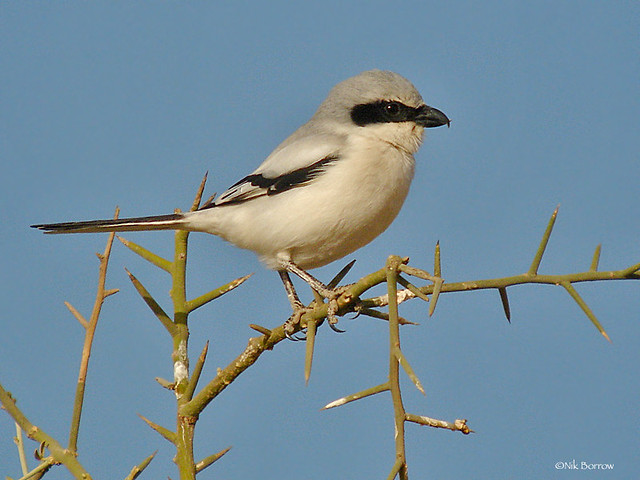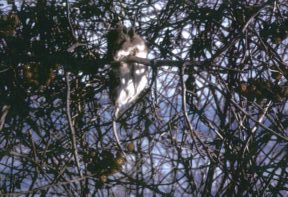Building Better Shrike Habitat

Iowa City finished construction of the South Sycamore Outlet Wetlands in 2001 and planted it in 2002-03. Early in 2003 I saw a shrike hunting there with its characteristic low undulating flight ending in a steep upward turn onto a projecting branch. In 2004 I saw a shrike again. Dan Schabilion then found a shrike pantry about a half mile to the east on a neighbor’s conservation property.
Pantry refers to the shrike’s habit of hunting large insects, mice, voles, and little birds and impaling some of them on the thorns of hawthorn shrubs for later consumption, hence their alternative name butcher bird. If hawthorn is not available, they will use smilax (catbrair), broken twigs, or barbed wire, but these do not serve as well.
There are two shrike species found in Iowa. The northern shrike is an Arctic and Boreal forest bird and only visits us occasionally in deep winter when food supplies run low. The loggerhead shrike is a more southern bird, and Iowa is at the northern edge of its range. According to the Iowa Breeding Bird Atlas: “The loggerhead shrike nests statewide, but is more common in the southern four tiers of countries, where they most frequently overwinter.” So if you see one around here in spring, summer, or autumn, it is most likely the loggerhead.
Ecologically the shrike plays a role quite similar to the American kestrel in terms of management of small prey populations. Both shrike species have been in steady decline for a half century, and the loggerhead has been on the National Audubon Society’s Blue List since 1972.

This is a house mouse, probably captured in someone’s yard a half mile away.
We had no hawthorns at South Sycamore, so in 2005 I cut some small trees, which were in the path of development elsewhere, and wired them upright in promising locations at South Sycamore. Later an impaled mouse was found on one of these.
A study of loggerheads in Florida led Yosef and Grubb to conclude that impaling prey is especially a courtship display by males, attempting to entice a female to their territory. So there might have been a breeding pair at South Sycamore that year, but I found no additional evidence of this.
The hawthorn experiment led me to research shrike species more thoroughly, and it turns out that their circumstances are similar worldwide. There are 29 or 30 species of shrikes around the world and most of them are in decline. The reason generally appears to be changes in land management patterns towards more “clean farming” and tidy landscaping. Shrikes are carnivores that hunt by perching on low branches in rather open areas and then pouncing on large insects, mice, and voles. The key to recovery of many shrike species appears to be simply providing additional hunting perches in appropriate habitat. In Florida cattle pastures, Yosef and Grubb increased loggerhead shrike density and nesting success by simply setting out a scattering of extra fence posts around the pastures (“control” pastures without extra posts did not show increases). In South Africa, the fiscal shrike has been similarly aided by artificial perch construction (see Devereux, C, 1998, The fiscal shrike. Africa – Birds & Birding 3:52-57). In Belgium, the red-backed shrike has recovered in pastures where brush piles have been built, shrubs were pruned to produce some bare horizontal protruding branches, and wads of old fence wire were piled in suitable locations. In Germany, great gray shrikes have returned to breed where more ragged effects have been built into agricultural fields, including rebuilding old piles of rocks removed from tiled fields.
Applying this research to our area, the most permanent shrike habitat is short grass prairie and permanent pasture. Wetland habitat changes with its hydrology. In wet years it can be tall and dense. But with drought, and muskrat “eat outs,” the vegetation is low and sparse and perhaps favorable for hunting shrikes. Many CRP fields are planted to dense stands of a switchgrass cultivar and seem impenetrable to birds. Grassland birds generally benefit more from plantings, which resemble the more open structure of native prairie.
Bur Oak Land Trust has recently begun to take an interest in ornate box turtles, which also need dry prairie habitat. With some minor modifications, this same habitat may also serve shrikes, specifically by planting a few hawthorns and low shrub thickets for nesting – perhaps of fragrant sumac. As far as I know, raccoons are the main predator of hatchling turtles and I have not heard or read of shrikes preying upon them, so they may be compatible in managed dry prairie. For more information on Bur Oak Land Trust’s ornate box turtle work, click here: Turtle-sniffing dogs headed this way for Bur Oak Land Trust project.
Shrike photo taken by Nik Borrow on Flickr creative commons.
Tags: habitat restoration, Lon Drake, shrike

